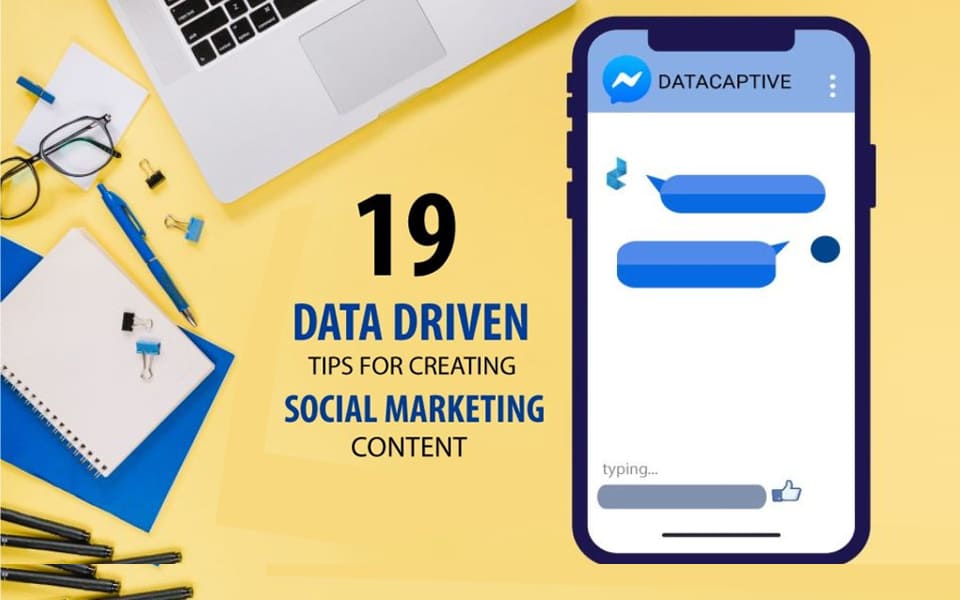Subscribe to Our Newsletter
Stay updated with the latest tips and strategies. Get additional discounts and alerts on offers.

To write the best online marketing content, you need to look at the data to find when, what, where and how to post it. This blog looks at hundreds of sources to find the best advice for creating content that will reach new audiences and the best ways to do it.
The three sections give a how-to of what content you should write – and also where you should place it globally. Here are 19 tips that will help you create and deliver great social media marketing content:
The most important content tool in social media marketing today is the creation of blogs. Firstly, they can improve your SEO, but they can also help give you great content to share and promote through social media
Blogs are a great way to raise a website’s SEO ranking, and the long tail key phrases embedded within them attract leads through organic search that are more likely to convert, with 53% of marketers listing blogs as their highest priority.
They also represent a good return on investment. They fulfil a function for SEO straight away, but 1 in 10 blogs are compounding – meaning organic search will increase their traffic over time, ultimately making up 38% of all traffic.
Business that blog regularly get more leads and traffic. The blogs that seem to perform best are those in a list form, with titles between 6 and 13 words including a number preferred by 36% of people – with 8 words being the best performer. Headlines with odd numbers did 20% better than even numbers.
Titles that end with question marks and had a better click through rate than exclamation marks or full stops, although a triple exclamation mark performed better than a single. After lists, the blogs that performed best included videos. 99% of the top pages also had a meta description and 80% had an H1 tag.
The top ranking blogs had a word range of between 1,140 and 1,285 words, but short form content of less than 1,000 words gets the least number of shares and links. Those with a word count of 3,000 or higher also tended to have a higher number of shares, but didn’t rank as highly.
Blogs which include research backed content and opinion forming journalism have the most likes and shares. Before talking to a sales rep, 47% of buyers view three to five pieces of content – so it needs to include material from all parts of the funnel. It should also include pictures; blogs containing them get 94% more total views.
Ultimately the blogs that perform best are those which are easy to read and are genuinely useful for the people searching.
Social Media is obviously a very important part of social media marketing. Before creating your content, you need to have a clear idea of your company’s position within your industry. You need to know your own Unique Selling Points as well as the Points of Difference you have from your competitors.
Once that is done, you need to research your audience and look at what they like and dislike before creating your content. A lot of what works can be discovered through experimentation – but you can fast forward through several tests with due diligence and patient research.

When considering which platform to post on, the clear winner is Facebook. In the US, 79% of people use Facebook, 32% use Instagram, 31% use Pinterest, 29% use LinkedIn and 24% use Twitter.
You should look at your business and your audience to see which one is the best platform for you. Although it is used by less people, 80% of B2B leads come from LinkedIN, and 94% of B2B marketers use LinkedIn to share their content. If your product lines up with people’s Pinterest interests – 87% of people of people on Pinterest have purchased because of content they saw on the platform.
Instagram is a great way to reach people, especially in the younger demographic, with 59% of 18-29 years old’s using the platform 75% of users on Instagram said that they have taken an action after seeing an advertising post on the platform.
There are a huge number of studies which all say different things about when you should post on different platforms. For Facebook, engagement seems to be higher on Thursdays and Weekends, with the best time to post being between 1pm and 5pm – and the worst time to post being between 7.00pm and 9.00am.
Tuesday from 10am to 11am is gets the most shares, with the best times to post being Tuesday through Thursday during work hours. The worst time to post is after 6pm and before 10am. With LinkedIn, as your messaging is only likely to reach 20% of your audience, you should aim to schedule up to 20 posts a week.
It seems that the best times to post are at lunchtime (between 11am and 1pm) and evenings (between 7pm and 9pm). B2C business will also get a better result posting on weekends than B2B – but Wednesdays and Thursdays seem to drive the most engagement.
As for what you post, there are some rules that apply to all platforms. Posts that include a picture get better engagement, especially if that image has people or animals in it. Bright colors and filters also get more attention. Video also gets more reach.
An 20% to 80% split between hard sales content and lighter brand awareness is also recommended. Posts with 80 characters or less get 66% more engagement, Posts with exclusives also do well, with 42% of people becoming a fan so they can access exclusive content.
You should post for your own objectives and the audiences objectives. That means every piece of content you produce should support your sales funnel. You should try and pull images and copy from your landing page, so that your advert will be more relevant – a factor that can reduce your costs and increase reach on Facebook.
Audiences go online for two reasons, to have their problems solved, and to be entertained. That means you should create engaging content that answers a need that your audience may not even realize they have.
Frequency depends on your audience and your preferred platform. On Facebook, the rule of thumb is that you should post once a day – on LinkedIn you can post up to 5 times a day as each message will only reach 20% of your audience. On Twitter, you can post up to 50 times a day, depending on your message and your audience, as the ‘life’ of tweets is much shorter.
The key is to experiment and find out what works for you. There are a number of tools available from social media platforms as well as third parties that will allow you to see what is the best time, frequency and even type of post for your audience. See what works for your company and your audience.
For certain industries, such as credit transfer – emerging markets have created a boom. If your product or service is online, and can be used by emerging markets – then you might want to think about the benefits of localizing your message and content to offer people in Africa and South America opportunities they never had before.
There are 7.5 billion people on the planet – and more than half (3.885 billion) are on the Internet. Nearly half of those are in Asia (1.938 billion), with China and India far outstripping the US. The Asian marketplaces have their own challenges, China’s legislation for example, but they have the largest online audience by far.
In fact, the number of North Americans on the Internet is the fifth largest of the seven geographic regions – With Asia first, followed by Europe (659 million), Latin America (404 million) Africa (388 million) – and the US has ‘only’ 320 million (followed by the Middle East at 147 million and Australia with 28 million).
f you’re looking at data to predict the future of Internet Usage, you may want to look at Africa. Since 2000, there has been an 8,503% growth in Internet Usage – with 31.2% of people in the country now having Internet access.
7 of the 10 fastest growing Internet populations in the world in 2017 were in Africa. Ethiopia tripled the number of Internet users, and Nigeria has the 7th highest number of Internet users in any country in the world, ahead of Germany, the UK, Canada and four times more than Australia.
The fact that the Internet can now be accessed on a mobile phone is opening up people’s access to digital media dramatically – with 2.7 billion people actively using social media through mobile devices. The global average data usage on a smartphone is 2.1 GB of data. Half the world’s web traffic now comes from mobile.
There are now more than 2 billion active Facebook users globally. Nearly 3 billion are on some kind of social media (including the Chinese regulated service Weibo). The US has the largest proportion of Facebook users, with 72.4% of people using the service, but the total number of users – 263 million is still fourth.
Despite only 17.7% of people in Asia being on Facebook, there are 736 million users in that region. Latin America has the second highest proportion of Facebook users after America (57.3) which means it has 370 million active Facebook users – over 100 million more than the US.
Globally, one out of every two people is on the Internet, and one out of every two people on the Internet is on Facebook. That proportion is steadily growing – but that growth is slowing in the English speaking world. In the Middle East, Saudi Arabia has seen a 73% increase in social media users, with the United Arab Emirates growing by 43% – in just one year.
English is the world’s largest business language – but it’s the fourth most spoken language after Mandarin, Hindi and Spanish. 51.6% of all content on the Internet is in English. Around 1.5 billion people in the world speak English (that’s 20%) and of those, 360 million speak English as a first language – more like 4%.
It means there are people who can really be reached by messaging and content that is in their own language. The Internet means things like translations, chat bots and automated checkout processes are now open to every business.
If you have the ability to deliver your product or service internationally, then you may want to think about changing your content to open up underserved, untapped and massive global markets.
Show Some Love!

Subscribe to Our Newsletter
Stay updated with the latest tips and strategies. Get additional discounts and alerts on offers.
Related Articles
Subscribe to Newsletter
Stay up to date with the latest marketing, sales, and service tips and news.


This Memorial Day, elevate your outreach with 30% OFF our industry-leading B2B contact databases. Build stronger pipelines, reach the right decision- makers, and drive real business growth — faster.

100% opt-in & compliance-ready contacts

95%+ data accuracy across every record

Access to 130M+ phone numbers & 2B+ contacts

Coverage in 140+ countries, 200+ industries
Whether you’re in marketing, sales, or business development — this is your moment to scale smarter.